Cycle # Patrick Park
Posted: May 2, 2022 Filed under: Uncategorized Leave a comment »For the last cycle I prepared a play space where the music evolves by positions or it activates one shot samples. The song I composed plays throughout the entirety of the experience. If the audience goes closer to the camera the voice switches from regular to pitched up voice. Vive versa, when the participant is moving away from the camera, the singing switches back to normal. In the mid spaces there were triggers that played notes in the scale the song was written in. In front there are trigger that turned on echos and delays (although it did not activate this time). In the back there are 808 bass drums and a snare sound. My plan was to create “out of bound” area where every track would be playing in reverse. This did not happen because making sure that the main interactive functions took a long time to actually work. In this cycle there were more excitement and urge to interact in the room than last couple cycles. Making sound triggers to interact together with a song is a fun idea. Hope to keep developing this.
Cycle @ Documentation Patrick Park
Posted: May 1, 2022 Filed under: Uncategorized Leave a comment »Cycle 2 I successfully was able to capture data from motion capture in Isadora and send them back to MAX/MSP to play the audio. There were five tracks that built into the whole song. I had 5 sections and each track being triggered by participant’s presence in front of the camera. Guitar, bass drum, snare, hi-hat, and pitched up voice played when standing in certain area. There were triggers that activated delays, echos, and distortion but they were not triggered during experience. This was better designed than the last cycle, nonetheless I could see rooms for improvement. I realized that having sounds play most of the time can be very frustrating and the song should play throughout the experience. Sound should not stop at all. Rather than placements having triggers to play the tracks, the song should be playing all the time. For the next cycle I plan on adding one shot samples of instruments that can be activated and play along with the song playing in the background.
Cycle 1 Documentation
Posted: May 1, 2022 Filed under: Uncategorized Leave a comment »For the first cycle I envisioned a motion detected sound scape. The furthest point from the motion camera played the beach ocean sound, as audience got closer, the beach sound changed to under water sound. Lastly when the participant got close to the camera, it would activate a salsa song. Though this experiment I realized that having just sound play from moving is not too stimulating. There were only three sound sources and I feel like I could have done more to this. Part of the issue that came up while working on this cycle 1 was that Isadora could not handle audio plugins being processed through the program. In the next cycle, I mean to take in motion capture data from Isadora and send it to MAX/MSP where I can work with more audio manipulation.
Pressure Project #
Posted: March 7, 2022 Filed under: Uncategorized 1 Comment »When I first heard audio project my brain started going in every direction of what to do. I could make a podcast, I could write music score, make a pop song, there were so many possibility. The only problem was telling a story that would make someone laugh. I’m not used to telling that kind of story in a song. I started to write the song but it just wasn’t coming off with the right vibe I wanted to give.
Later that day I was hanging out with my roommate in the balcony watching the neighbor take out their dog and not picking up after their dogs and we were commentating this entire situation from our open balcony (as in if they walked over to our direction 10 feet they could probably hear what we are saying. We were just being stupid, saying things that didn’t make sense like pocket poop that you would throw at people you didn’t like.
Then it struck me.
I didn’t know what to do with the topic of cultural heritage because I don’t have a “cultural heritage” other than my friends that I am closely connected to. After immigrating from Korea, I had to build my new home, a new culture and custom for myself. And I found that home in my friends that I grew up with.
So I started to dig through my collections of recordings I have on my phone to get some inspiration. Found some clips of recordings I got from different times. I wanted to make a sonic dialog that had a message if you dig through but on the surface it just seems like music happening with words. So I started sampling some beats I’ve made, and put the recordings on top of it and create a flow to the dialog that I wanted. Polished the recordings with EQ and other effects that made it sound hazy. Automation for progress of development of the effects.
Overall, I really enjoyed the creation process of the project and I had fun making art (which I have’t felt in a while so it felt good to make something and feel good about it).
Enjoy the recording 🙂
Pressure Project @ – Patrick Park
Posted: February 22, 2022 Filed under: Uncategorized Leave a comment »Reveal your secret! What is a secret and how could I reveal it to the people (our classmates). I started by revisiting past week materials and recordings on what we have learnt on isadora. Flipping through the old recordings, my thoughts about “revealing a secret” changed from literal secret to “if a certain condition is achieved by the audience then certain action will happen”.
Once I was able to categorize my thought process as “whatever I make the audience do, that is the trigger. Now what do I want my trigger to do?” So naturally I started with the shape actor and started thinking about what could be manipulated in this actor. This thing that the audience is manipulating should be visually apparent enough that “oh! If I do this, this happens!” Since the easiest thing that one could recognize the change of is color I’ve decided that color would be what changes visually.
After I had decided that I was going to manipulate colors, it was a matter of setting up the system in isadora. To run the tests before connecting to the makey makey, I used the letter a, s, and d as a test trigger. The ‘a’ triggered the change in color of the inner square, ‘s’ triggered the outline of the square, and finally ‘d’ triggered the background color. I was able to achieve this by using a ‘sequential trigger’. Sequential trigger allows each trigger that this actor receives the output to be triggered sequentially (ei. Click ‘a’ and Output 1, output 2, output 3 is triggered with each press sequentially). From the sequential trigger I built a trigger value that plugged into a random actor. The random actor then goes into limit-scale value which will take any values that the random is giving and scale it to the numbers I have set. Each of these random values plugged into ‘red’, ‘green’, ‘blue’ of color maker RGBA. This process was copied and pasted as the main function of my patch.


Since I have achieved basic function for each trigger (each button changes color in a specific area), I wanted the triggers to do something when a condition is met and when triggers were activated together at the same time. I made the condition of the trigger to be pressed for 3 seconds. I achieved this by putting together a keyboard watcher into a timer actor. When a trigger is pressed it will start to run the time, this output is connected into float to integer actor so the actors involving integer input can understand the time information. Float to integer actor is connected to Inside range actor which sends a trigger when a number you’ve set is inputted into this actor. This was then connected to the gate actor, which controls if the trigger is going to push through at the end.


When you press ‘a’ for three seconds the line size will change line size making the inner square small and bigger. When you press ‘d’ for three seconds the background will start to change automatically.
Finally I wanted the secret to be revealed when all three triggers were to trigger at the same time. Since the color was changing the most dramatic thing to do in my mind was to move the squares. So using the simultaneity actor, I’ve set it up so if all three triggers are triggered within 0.5 seconds, then it will activate the pulgeneraters which are connected to the wave generator. Finally the wave generators are plugged into the vertical, horizontal, and rotational section of the shape actor.

Things that I’ve noticed as learned: My particular patch doesn’t give the motivation to find the secret without the context of this assignment which I thought was interesting. The question I got the most during my presentation was “is this the secret?” 🤐 🤫 maybe designing how to make people want to look for a secret? and having a clear indication of “you have achieved it and came to the next part of the thing” is something to think about for the future projects.
Pressure project !
Posted: January 27, 2022 Filed under: Uncategorized Leave a comment »I chose the intersections of the one ways and Summit st. Summit is a two lane one way street with parked cars on each side of the road, with two way bike path. So realistically summit is a 5 lane streets taken up with w lanes of parked cars. Throughout my observation I remembered how terrible it is to turn on to summit because you cannot see through the parked cars for the on coming traffic of the summit. So I started taking notes on my iPad of traffic patterns and eventually transferred them to a mind map.
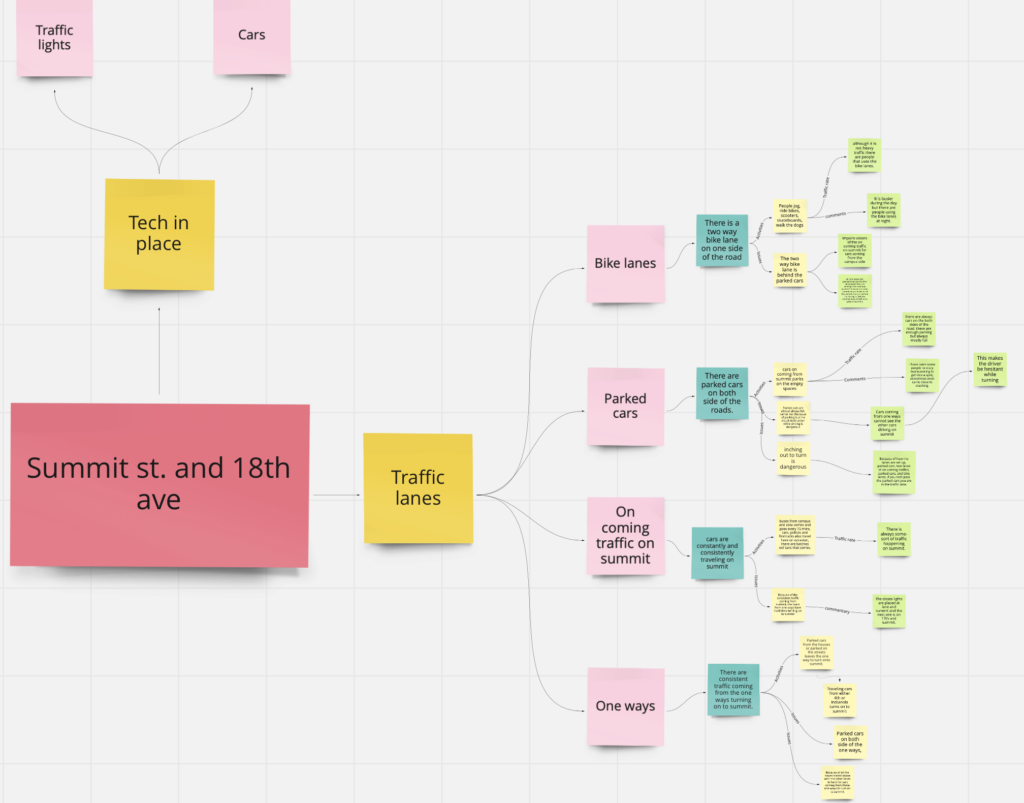

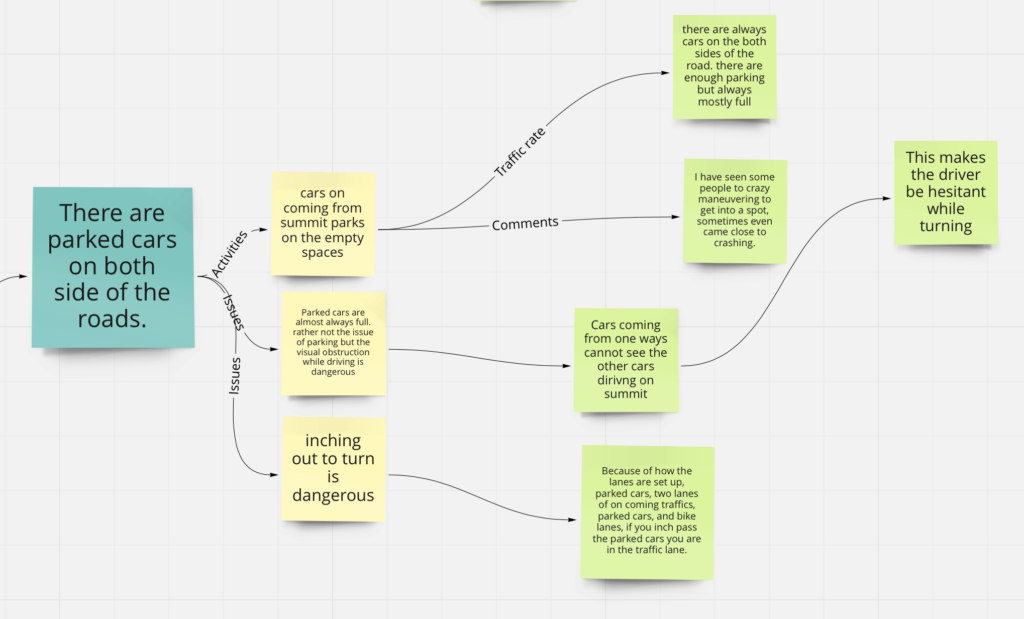

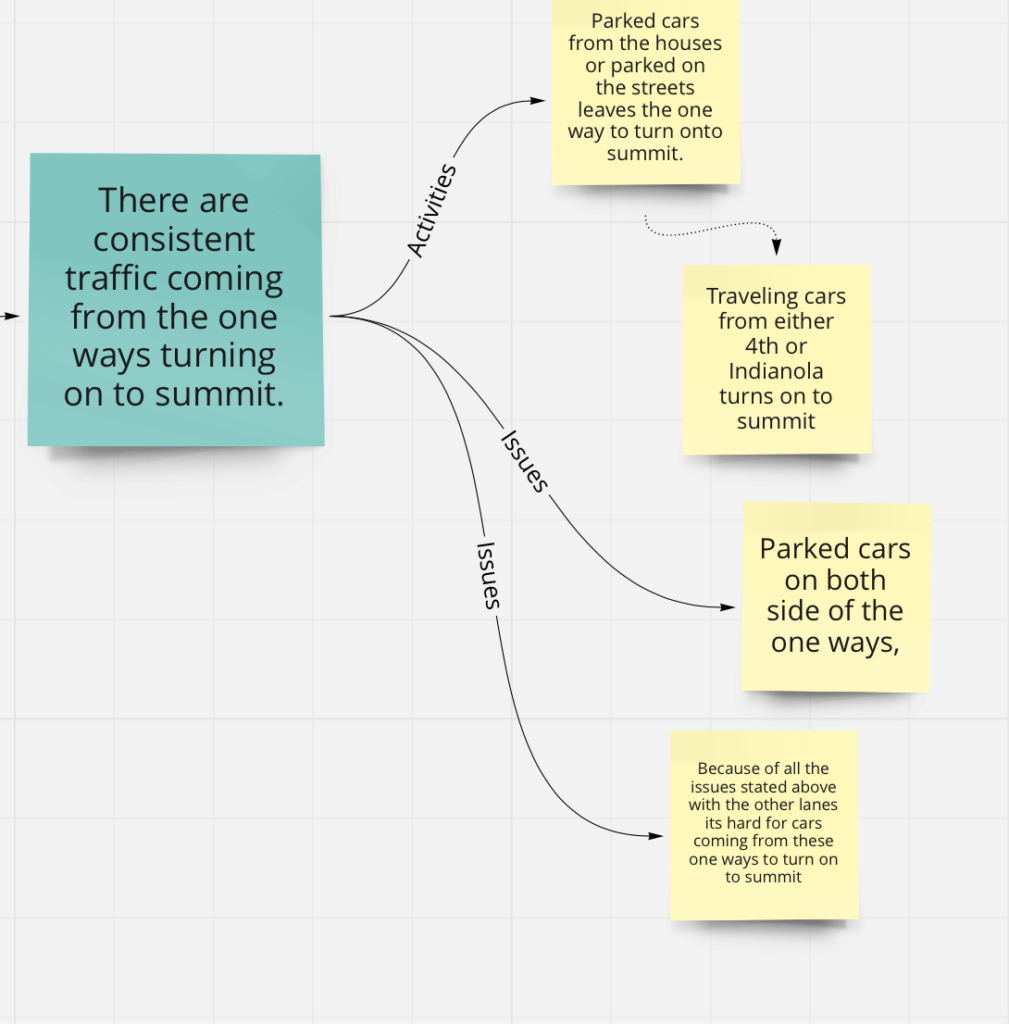
After taking notes and organizing them I tried to think of ways to help with these issues and made a mind map.
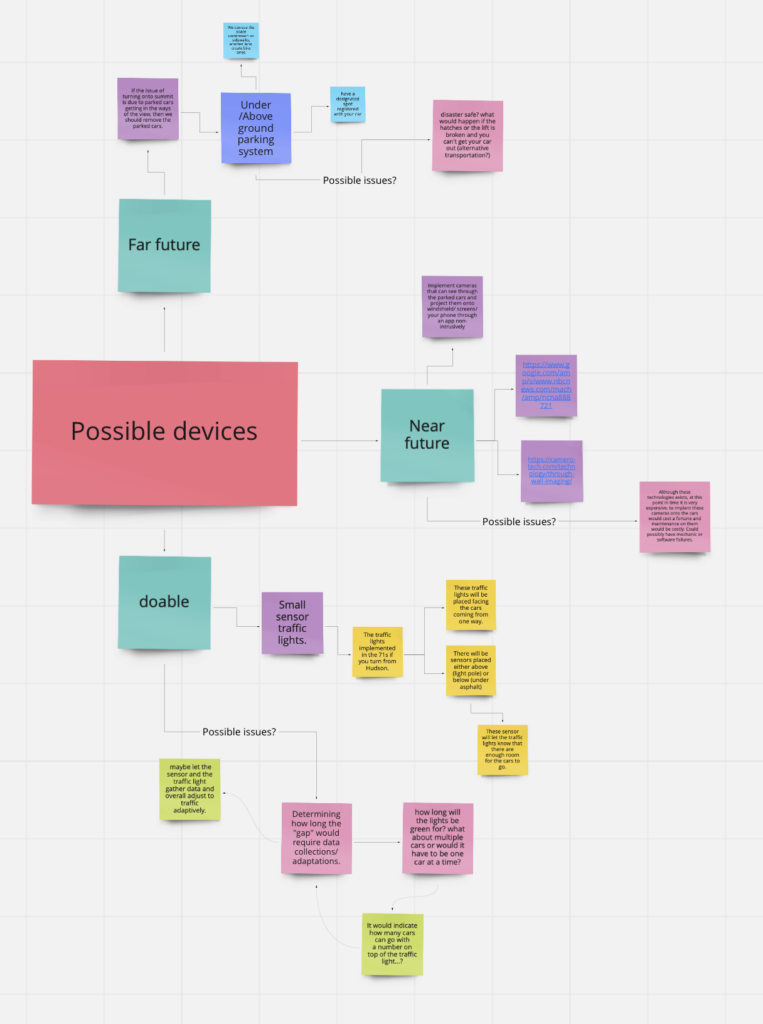
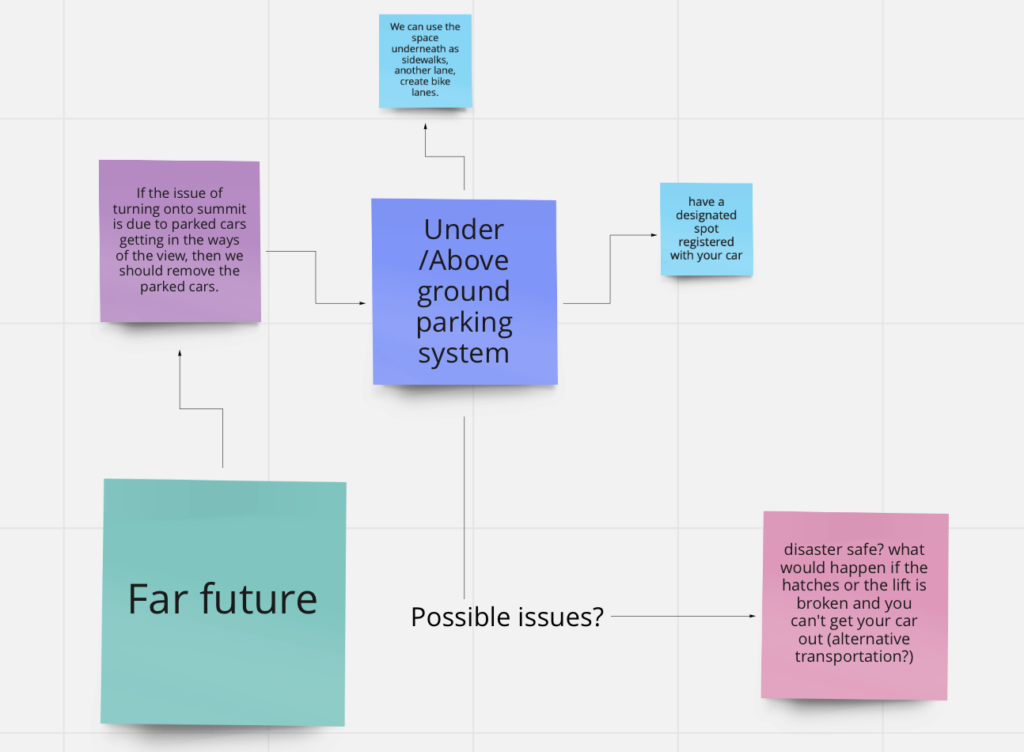
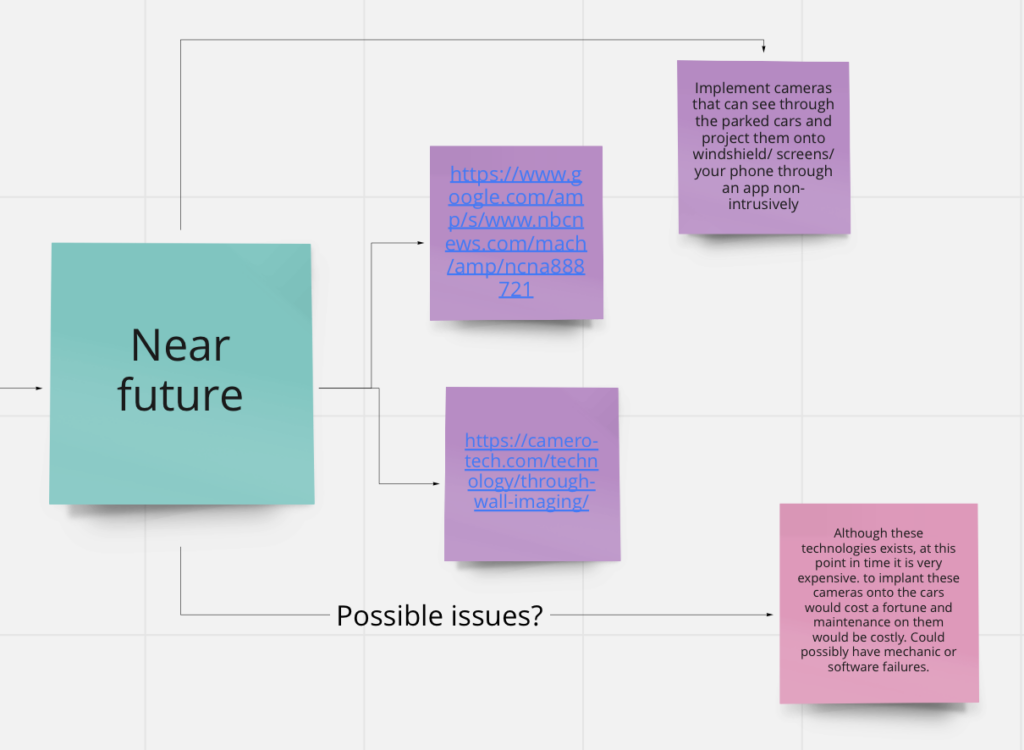
These are two links that are in the mind map. it talks about see through walls tech If anyone is interested.

In conclusion, there are possible implementable actions we could plan and initiate, we just haven’t figured out where the taxes we paid last year went.
Project bump
Posted: January 25, 2022 Filed under: Uncategorized Leave a comment »https://dems.asc.ohio-state.edu/wp-admin/post.php?post=2768&action=edit
I was looking through some of the pressure project and this caught my eyes because of the description and the though process of developing the program was well intended and planned then executed. Understanding what kind of work and thoughts that goes into making art, following through with the intention and plan is hard to do at times especially with these projects that has a limited time. I liked the intention and the art that came from that intention.